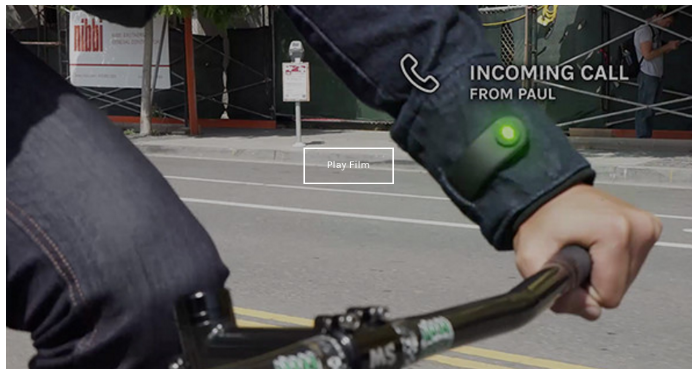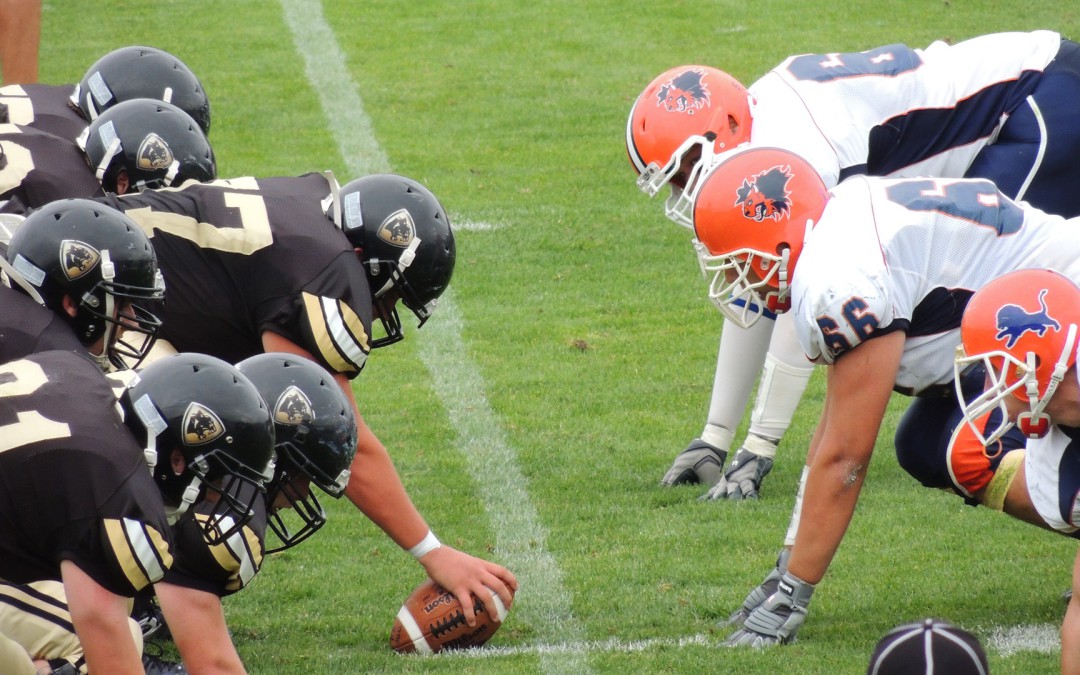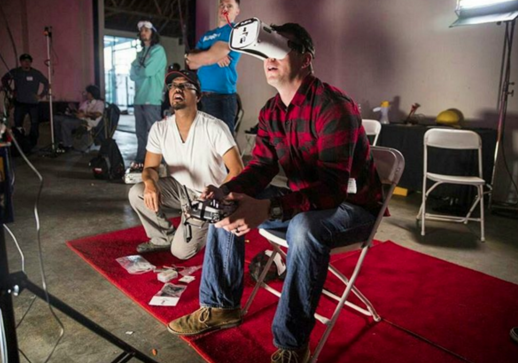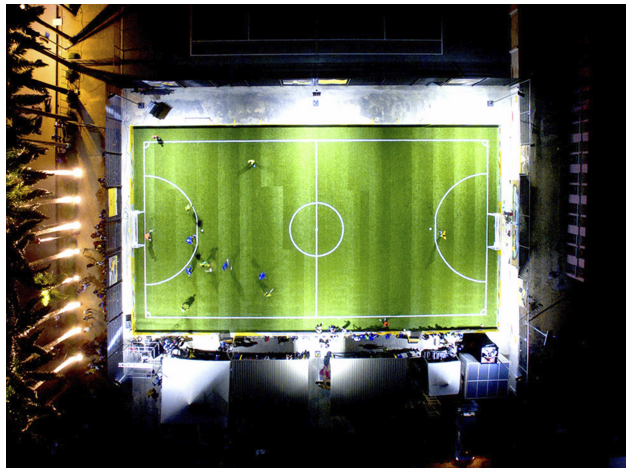
by Don Basile | Jun 10, 2016 | Sports, Tech
I’ve been excited about Google’s secretive Project Jacquard since it announced a collaboration with Levi’s last year. Now the collaboration has come to fruition in an innovative jacket featuring technology woven in, and specifically designed for urban bikers. This is just the start for Project Jacquard, which promises the ability to weave touch and gesture interactivity into a wide array of textiles, from clothing to furniture.
Scheduled to start shipping in spring 2017, the Levi’s Commuting Trucker Jacket will allow cyclists to play music, listen to directions, accept phone calls and more with the simple swipe on the sleeve of the jacket. This is a much safer alternative than trying to maneuver a bike and smartphone at the same time. Check out the jacket in action here.
So how does it work? It all starts with innovative jacquard yarn, which combines metallic alloys with natural and synthetic yarns like cotton and silk. When combined with traditional thread materials, the alloys are then strong enough to be woven on industrial looms. For the commuter jacket, gesture sensitive areas were woven directly into the fabric near the wrist, for easy access while biking. With a rechargeable tag on the cuff, the jacket then connects via Bluetooth to the user’s smartphone. The tag, inspired by classic trench coat designs, can be removed and the jacket can be washed like regular clothing.
This is a great example of wearable tech moving in a new direction, where form and function truly align without one being sacrificed by the other. In the future we can expect to see more exciting Jacquard partnerships that reimagine what can be done with technology woven directly into textiles. The commuter jacket is just the tip of the iceberg.

by Don Basile | May 5, 2016 | Sports, Tech
If you’ve ever gone for a run and gotten into that pleasant state of motion meets relaxation, you know the feeling of a runner’s high. The pleasant feeling of having released stress and gotten the blood flowing can last long after you take off your running shoes. This alone is a great reason to become a runner!
Endorphins—those neuropeptides released by the brain during periods of exercise or stress— have long taken all the credit for producing the runner’s high.Turns out it may be another substance that deserves the credit for producing this natural high.
When researchers in the 1980s discovered that blood levels rise after exercise, the logical takeaway was that endorphins were released by the brain to stimulate that natural high feeling that a good run can produce. But endorphins are large molecules, which would make it unlikely that they could pass through the brain-blood barrier. Instead, a smaller molecule called endocannabinoids seems a more likely contender for bringing on that carefree feeling.
Endocannabinoids are essentially the body’s very own marijuana molecules. They’re small enough to pass from the brain to the bloodstream and attach to receptors there. Might these natural stimulants be the real reason for the runner’s high?
Researchers at the Central Institute of Mental Health at the University of Heidelberg medical school in Mannheim, Germany seem to think so. After conducting research on lab mice to study the effects of endocannabinoids vs. endorphins after bouts of exercise, they found that blocking the cannabis molecules prevented the post-run high. Blocking endorphins, however, did not have the same effect. Which means it couldn’t have been the endorphins bringing on that elevated feeling.
While this research is more suggestive than substantial, as it concerns mice and not necessarily humans, the implications are interesting. As a species, our biological makeup has always encouraged us to run, from potential predators and as hunters. Throughout evolution, our body has preserved this inner reward system for running. Even if science can’t fully explain the runner’s high yet, anyone who has ever experienced it knows that it’s a great feeling, and well worth running for.

by Don Basile | Apr 25, 2016 | Sports, Tech
As the science of quantifying human performance becomes more common, biometric tracking services have burst onto the athletic field as a tool to optimize player performance. Increasingly, research shows that monitoring certain biomarkers, such as hormone and glucose levels, yields data that can be used to personalize training and custom-tailor athletes’ nutrition and workout regimens. Dozens of players in the NBA, NFL, and MLB, as well as U.S. olympic athletes, are using DNA and blood tests to gain insight into their genes and biochemistry.
The term biometrics refers to the science and technology of measuring and analyzing biological data, including hormone and glucose levels. A handful of startups are making inroads in the sports biometrics market: Catapult, Insidetracker, DNAFit, Whoop, and Agewell are arguably the most publicized.
Though each company differs in its approach to biometrics tracking, all of these startups offer services that include a blood test and screening. Following bloodwork, each user receives a personalized report providing an inside look at his or her biochemistry. The reports—usually an analysis of 30 to 40 biometric markers—contain detailed information about users’ internal organs and functioning. Typically, the biometric markers in the analyses include (but are by no means limited to) the body’s glucose levels, hormonal levels, cholesterol, vitamin D and vitamin B levels, and red blood cell count.
Metrics Mean More Home Runs
Athletes who pay attention to these analytics do so to maximize their health, energy, and preparedness for competition. Players apply the data in more granular ways, too. Within Major League Baseball, veteran Pittsburgh Pirates pitcher Mark Melacon is among a growing number of players who use biometrics to inform their training. Melacon uses the data from InsideTracker to keep an eye on his cortisol levels.
Notably, the Playing Rules Committee for MLB approved two devices for use during the 2016 season: the Motus Baseball Sleeve, which measures stress on elbows, and Zephyr Bioharness, a kind of smart sensor patch that monitors heart and breathing rates.
Better Cycling Through Biometrics
And baseball is just one of many sports in which biometrics monitoring has become trendy. At the 2012 Summer Olympics in London, the U.S. women’s track cycling team won the silver medal. The team says their use of biometrics data helped them accomplish the feat. Data provided by InsideTracker identified cyclist Sarah Hammer’s vitamin D deficiency. Another member of the team, Dotsie Bausch, learned she had what’s known as “the sprinter’s gene.” The knowledge about Bausch’s DNA resulted in a revision of the women’s race strategy, as well as a total overhaul of Bausch’s individual olympic training.
More than a dozen NBA teams are using products made by the sports biometrics company Catapult, according to a report written in July 2015 in Reach magazine. The Bulls, Mavericks, and Spurs are interested in monitoring players’ exhaustion levels, in particular.
There’s no question the growing popularity of biometrics tracking among pro athletes is notable. But why is this trend so significant?
Athletes’ interest in biometrics data is part of a larger trend:
The recent interest among athletes represents the tip of the personalized medicine iceberg. With growing interest and rapidly advancing technology, we can expect the cost of biometrics screening to decrease and become more popular among mainstream consumers within the next few years.
What about privacy issues?
Blood contains a lot of personal information. The same biometrics data that can optimize an athlete’s performance is also the most personal data imaginable: records of heart rate, speed, strength, their ability to withstand blows. It’s not far-fetched to think an NFL or MLB team might consider this data before trading a player, or before renewing a veteran’s contract. For MLB players especially, blood tests are fraught with the sport’s long history of steroid and amphetamine use.
For sports franchises, athletes are investments:
Team owners and trainers have a financial incentive to encourage this kind of monitoring. In an article published in The Atlantic, Leslie Saxon, the director of USC’s Center for Body Computing, discusses the power of money to incentivize in this way. Professional athletes, Saxon points out, are “the most expensive human real estate in the world,” and in the future, coaches and trainers will undoubtedly rely on biometrics to safeguard athletes’ health and prevent player injuries.
Still, some critics remain skeptical of biometrics and of the performance optimization trend. They believe its potential to improve performance is overemphasized. And yet, athletes who monitor their biochemistry aren’t expecting their earned run average to plunge, or their points per game numbers to skyrocket. Players appreciate that the import of biometrics data is subtle.
It will be interesting to see what the performance optimization trend will look like several years down the road. Once biometrics tracking is ubiquitous among serious athletes, it’s likely that its usage will become more widespread and mainstream. Sure, biometrics tracking could be a fad. But it might also be the key to achieving wellness—for athletes and ordinary folks alike.

by Don Basile | Apr 8, 2016 | Sports
Football has never been more popular. Some would say it has replaced baseball as America’s favorite pastime. But it’s tricky to predict what football will look like in another 50 years. Earlier this week, Jeff Miller, the NFL’s Vice President of Health and Safety, publicly acknowledged the connection between football-related head trauma and chronic traumatic encephalopathy (CTE). Miller’s acknowledgement is a big deal, as Steve Fainaru points out in a recent article for ESPN.com. It’s “the first time a senior league official has conceded football’s connection to devastating brain disease,” Fainaru explains.
The link between high-impact blows to the head and traumatic brain injury may seem obvious to us in 2016, but it hasn’t always been that way.The NFL’s formal admission before Congress goes against the findings of a league-funded 1994 research study, which repeatedly denied any links between football, concussions, and brain disease (“and attacked independent scientists who asserted otherwise,” according to Fainaru). More importantly, Miller’s statement could provide a leg up in the courtroom for the 5,000+ ex-NFL players who have sued the NFL for damages related to brain injuries. Cringe-worthy collisions are not worth the long term risks.
Conceptually, concussions aren’t so difficult to understand. Your brain sits inside your skull, surrounded by a thin layer of cerebrospinal fluid. But the fluid, which acts as a protective barrier, cannot provide sufficient protection if your head sustains an impact with enough force. During these “blows,” your brain bounces against your skull, damaging axons and the brain-blood barrier in their wake. Yikes.
Relative to other neurological conditions, scientists know surprisingly little about concussions. They understand how they happen, sure. But if concussions are point A and CTE is point B, scientists aren’t sure which route connects the two.
Many college and professional sports are aware of the danger that repeated concussions pose to pro athletes and are responding accordingly. The New York Times reported this week that the Ivy League now prohibits full-contact play during team football practices. And NFL and college football players aren’t the only ones at risk. The rise of competitive youth sports leagues means that athletes are experiencing those collisions at earlier ages, when the brain is still developing.
There’s a long history of athletes’ reluctance to adopt new equipment. In Major League Baseball’s early days, chest protectors and shin guards were derided as “tools of ignorance.” Since then, the MLB and also the NHL have made reducing players’ risk of injury a priority with required protective gear. The NFL needs to enact similar safety measures. Still, league officials must negotiate a tough question: when is safety a personal responsibility? At what point does inaction turn into negligence?
Both the MLB and the NFL have several helmet-related initiatives in the works. The NFL recently gave Vicis, a startup in Seattle, a grant of $500,000 to engineer a concussion-proof helmet; Vicis is slated to debut their new product this coming spring. The timeline below outlines the evolution of safety and equipment rules in major league sports.
PRO SPORTS PROTECTION THROUGH THE AGES

1878: First baseball catcher’s mask is patented.
1907: New York Giants’ catcher and Hall of Famer Roger Bresnahan wears shin guards, becoming the 1st MLB catcher to wear protective gear in open view.
1939: John T. Riddell Company introduces a plastic football helmet, which proves to be more durable than leather models.
1940: Chicago Bears’ Dick Plasman becomes last NFL player to play in a game without a helmet.
1943: NFL mandates that all players wear helmets.
1955: Popularized by legendary Cleveland Browns quarterback Otto Graham, the “single bar” helmet is worn in the NFL.
1956: MLB “grandfathers in” helmets i.e. new players entering the league must wear helmets.
1962: The NFL requires that players wear helmets with face masks.
1968: NHL player Bill Masterton, a center for the Minnesota North Stars, hits his head on the ice in a game versus the Oakland Seals, causing a fatal brain aneurysm. Masterton becomes the first and only player in NHL history to die due to an on-ice incident.
1971: MLB requires all players to wear helmets while batting and running the bases. Catchers must wear them in the field.
1979: NHL makes helmets mandatory for new players entering the league; veterans have the choice of whether or not to wear one.
1983: All MLB players entering the league must wear a helmet with an ear flap.
1991: The first serious attempt by the UCI to introduce compulsory helmet use during the Tour de France. The UCI backs down after cyclists threaten to boycott the race.
1997: The last NHLer to play without a helmet, Craig MacTavish, retires.
2002: Riddell releases the Revolution (or Revo) Helmet, which most NFL players begin wearing.
2003: Turning point in cycling’s helmet policy due to the death of Kazakh Andrei Kivilev. The 2003 Giro d’Italia is the first major race affected. Bikers are still allowed to discard their helmets during final climbs that are at least 5 kilometers in length.
2009: Cubs pitcher Ryan Dempster becomes the first MLB player to wear Rawlings’ new S100 helmet, which offers better protection than the company’s standard helmets.

by Don Basile | Apr 4, 2016 | Sports, Tech
Star Wars fans, take note: for the first time, you have a shot at being a pod racer just like the young Anakin Skywalker in The Phantom Menace. Well, maybe not quite like Anakin, but quadcopter racing is about to take the extreme sport world by storm.
Underground quadcopter racing is already hugely popular in Australia, and we can expect to see the exciting medley of sport and virtual reality becoming mainstream in America soon too.
First person view (FPV) takes this sport to the next level, allowing pilots to sit in lawn chairs and fly speedy little drones around amazing venues—from abandoned warehouses to pristine forests—while experiencing the rush firsthand. Pilots wear goggles that transmit live video from a camera mounted at the front of the drone, and the footage is crazier than a rollercoaster ride.
 What sets drone racing apart from other sports is that it’s not innate athletic ability or hours spent training in a gym that makes a successful racer. Instead, it’s a sport where anyone can excel, given a love of technology and an enterprising spirit. Drone racing is a sport in which spectators become athletes and geeks become gods. It’s an alluring premise, and one that the newly created International Drone Racing Association thinks will make for great television and huge cash prizes in the not too distant future.
What sets drone racing apart from other sports is that it’s not innate athletic ability or hours spent training in a gym that makes a successful racer. Instead, it’s a sport where anyone can excel, given a love of technology and an enterprising spirit. Drone racing is a sport in which spectators become athletes and geeks become gods. It’s an alluring premise, and one that the newly created International Drone Racing Association thinks will make for great television and huge cash prizes in the not too distant future.
Created last April to bring together over 500 racers and drone enthusiasts, the International Drone Racing Association hopes to spur drone innovation, organize world class races, and promote education and awareness around the burgeoning sport. As the sport has grown so quickly, there are still a lot of details that need to be figured out, including how best to view the sport as spectators, what the rules of competition are, and the best venues in which to hold races. Essentially, drone racing is only in its fledgling stage, but one look at a Youtube video of popular FPV racer known in the community as Charpu makes the sport’s appeal instantly clear.
Money is also starting to flow into the sport by investors eager to ride the wave of the next big sports tech trend. Miami Dolphins owner Stephen M. Ross invested $1 million in the Drone Racing League, which has recently launched its competition series with more than $8 million in overall funding. The first “level” of competition was fittingly held at the Sun Life Stadium, home of the Miami Dolphins. As they reach speeds up to 80 MPH, watching these drones fly, dodge and dive is exhilarating, if not a bit nauseating at times. Check out the highlights on the Drone Racing League site.
Most of the current racing drones are made out of carbon fiber, four propellers, a motor, a battery and some circuitry—meaning there’s endless potential to upgrade quadcopter technology. The companies that get on the forefront of developing a better spectator experience, as well as technology that’s less fragile, are sure to cash in on this emerging trend in extreme sports.
Photo Credits: Instagram/International Drone Racing Association

by Don Basile | Feb 23, 2016 | Sports, Tech
Africa is increasingly becoming known for its green energy initiatives, from wind farms in Kenya to solar power plants in Rwanda. The latest green energy breakthrough comes from Lagos, where the world’s first solar and kinetic energy powered soccer field was just built.
Opened last month, the field is located at the Federal College of Education in Akoka. Constructed with a layer of tiles under the turf that transform players’ footfalls into kinetic energy that helps light up the field at night, this renewable field is a great example of out of the box thinking when it comes to the possible applications for green energy technology.

Launched as an initiative between energy company Shell, the rapper Akon and London-based startup Pavegen, the field is the culmination of three years of teamwork and collaboration. Pavegen is responsible for the 100 rubber paving tiles that capture and convert footfall energy to light floodlights around the stadium. The startup’s goal is to provide low cost energy effective solutions in Africa, and the field in Lagos marks their biggest application to date.
Combined with solar panels, the kinetic tiles can power streetlights around the field for a full 24 hours—ensuring that night games are played safely. A soccer field is a great application for this technology, which requires an area to have heavy foot traffic. Other potential applications could be in schools or shopping centers.
Rapper Akon has also made great strides in bringing awareness to the need for electricity in Africa through his foundation, Akon Lighting Africa. Launched in 2014, the foundation seeks to support grassroots efforts to bring solar energy to rural areas in Africa. To date they have brought projects to life in 14 African nations.
While this is Africa’s first people-powered field, it’s actually the second venture between Shell and Pavegen. The first field, completed in 2014, allows children in Rio de Janeiro to play safely at night by light provided by their footfalls. Legendary Brazilian soccer star Pele was on hand for the inauguration, praising not only the country’s rich soccer heritage, but also the value of using science to power the solutions of the future.
Pavegen has big ambitions for their tiles. With production methods still being refined (which will bring the cost of the tiles down), in the future we might see entire stadiums paved with these tiles. Not only would player momentum create energy, but imagine the collective energy that could be harnessed from a hundred thousand fans celebrating a goal in the stands. The future for this innovative application of green technology is certainly shining bright.
Photo credits: Pavegen








